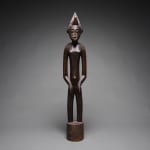Male Senufo Wooden Pombiele Rhythm Pounder, 20th Century CE
Wood
height 99.7 cm
height 39 1/4 in
height 39 1/4 in
PF.5021 (LSO)
Further images
This powerful sculpture is a pombilele or “rhythm pounder” from the Senufo peoples of the Ivory Coast and Mali. It is an unusually refined example of a traditional form. The...
This powerful sculpture is a pombilele or “rhythm pounder” from the Senufo peoples of the Ivory Coast and Mali. It is an unusually refined example of a traditional form. The base is columnar, supporting the figure’s comparatively long legs (without feet) and slender body. The upper arms are very long, the forearms surprisingly short and the hands resting on the hips’ each joint is flexed, providing extra movement through the piece. The sex of the sculpture is deliberately ambiguous; what might be breasts are very modest (they are usually prominent on females) and the genitalia are only suggested. The neck is thin, the face somewhat lugubrious with a rounded T-bar brows/nose complex, ringed eyes and open mouth. The coiffure is high and crested, the ears prominent and plate-like. The figure is monolithic in its simplicity, the only non-facial detailing being the umbilicus, nipples and bracelets around each wrist. The patina is very dark, which adds to the sculpture’s presence, although the base is pale in colour.
The Senufo group, based in the Ivory Coast and Mali area, has a long history of using highly decorated objects in many aspects of everyday life. However, their extremely high level of skill in woodcarving is nowhere better seen than in the realm of their magical-religious art. At the heart of Senufo society is a patriarchal groups of elders known as the Poro society, which is responsible for many religious and more urbane functions to do with the running of the tribal group. Their ceremonial events are often associated with dancing, music and the use of Pombilele sculptures.
“Pombilele” literally translates as “those who give birth”, and traditionally constitute a pair of figures (one male, one female) who represent primordial humanity and the ancestry of all humankind. Most examples, however, are of single, female figures. The appearance of these figures is relatively homogenous, being tall, slim and somewhat angular. However, the personal characteristics of each sculpture were often based upon a dream or vision by a Poro elder. There is also some social and geographic variability. The figures were used as pounding devices (holding each arm) to keep the rhythm for dancing, or were stood for purposes of contemplation in the middle of the Poro society’s sacred enclosures. They are also used for the interment of prominent Poro members; they are carried to the graveside with the dead body, then used to tamp down the earth on top of the grave, to ensure that the spirit of the dead is directed to the afterlife rather than returning to haunt the living.
This is a striking and attractive piece of African art.
The Senufo group, based in the Ivory Coast and Mali area, has a long history of using highly decorated objects in many aspects of everyday life. However, their extremely high level of skill in woodcarving is nowhere better seen than in the realm of their magical-religious art. At the heart of Senufo society is a patriarchal groups of elders known as the Poro society, which is responsible for many religious and more urbane functions to do with the running of the tribal group. Their ceremonial events are often associated with dancing, music and the use of Pombilele sculptures.
“Pombilele” literally translates as “those who give birth”, and traditionally constitute a pair of figures (one male, one female) who represent primordial humanity and the ancestry of all humankind. Most examples, however, are of single, female figures. The appearance of these figures is relatively homogenous, being tall, slim and somewhat angular. However, the personal characteristics of each sculpture were often based upon a dream or vision by a Poro elder. There is also some social and geographic variability. The figures were used as pounding devices (holding each arm) to keep the rhythm for dancing, or were stood for purposes of contemplation in the middle of the Poro society’s sacred enclosures. They are also used for the interment of prominent Poro members; they are carried to the graveside with the dead body, then used to tamp down the earth on top of the grave, to ensure that the spirit of the dead is directed to the afterlife rather than returning to haunt the living.
This is a striking and attractive piece of African art.





